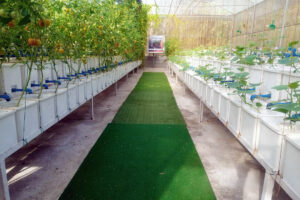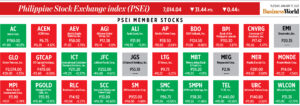Spurred on by the pandemic, hydroponics farming thrives

By Patricia B. Mirasol, Reporter
HYDROPONICS farming gained momentum in cities after the pandemic threatened to cut urban areas off from access to food, with the limited growing area required proving to be suitable for built-up areas with limited open space.
With only one square meter needed to grow 2.5 kilograms of lettuce, soil-less planting methods are demonstrating their potential in a rapidly urbanizing country, though there are examples of rural hydroponics farms.
With proof of concept having been demonstrated, the next phase of developing the industry has now moved to a fairly advanced stage — tailoring the nutrients to the plants deemed suitable to urban growing.
“Interest was generated during the pandemic, especially in the urban areas, (because) urban areas don’t have access to food,” Roberto F. Rañola, Jr., an agriculture economics specialist and chairman of the Philippine Association of Agriculturists, said.
“The market really is in urban areas,” Mr. Rañola said in a Viber call. Citing organic vegetables, he said, “Not sure if all were really organic like the (sellers) say they are, but they can command a higher price, and people go for it because they think it’s healthy.”
“It’s the same thing. There is a market niche for it,” he added.
FOOD SECURITYThe owner of Project Natural Farming, which conducts online agriculture training and supplies vegetables to hotels and restaurants, said that its usual market is the upper middle class, which are “the ones who are into salads and healthy living.”
Keith F. Hernandez, also a Technical Education and Skills Development Authority accredited instructor for natural farming, said interest had broadened with trainers “seeing a lot of people who want to study for food security.”
According to the 2022 Food Security Index, the Philippines was 67th out of 113 countries in the food security matrix. President Ferdinand R. Marcos, Jr., in a January World Economic Forum meeting, said that food security is at the forefront of the national agenda.
“We must invest in facilities, logistics, and systems that bring nutritious food to our people, much like a grander scale of farm-to-table and increase the capacity of our institutions to enforce regulations that enhance food quality,” Mr. Marcos was quoted as saying.
About 2.9 million Filipinos suffered from involuntary hunger in the third quarter of 2022.
QUALITY CONTROLAn advantage of hydroponics is its “strict quality controls, producing high-quality products,” Mr. Rañola said.
Quality is the industry’s selling point, according to Rafael L. Pagaling, owner and Learning Site for Agriculture operator of Zennor Hydroponics Farm in Zambales. He said that farm sales grew 20% in 2022 as compared to 2021.
“Tumaas po ang sales (Our sales increased) because we are producing premium quality,” Mr. Pagaling said in a Viber message. “Mas gusto kasi ng mga customers namin mga veggies namin kasi hindi kami nag-spray ng (Our customers like our veggies more because we don’t use) pesticides at insecticides.”
“Virtually any vegetable” can be grown with hydroponics — provided the grower knows what each plant’s nutrient needs are, Mr. Hernandez told BusinessWorld by phone.
PROPER EDUCATIONProduction costs, Mr. Hernandez added, can also be reduced by customizing nutrient solutions, which are different for each plant.
“People think na ’yung makita mo sa YouTube, ’yun na ’yun (that what you see on YouTube is the whole story),” he said. “There’s so much more. If properly guided, your cost of production for lettuce could be P10 per kilo. ’Yun ang hindi alam ng tao (That’s what people don’t know).”
Proper education for those interested in the field will help grow the hydroponics market in the Philippines, according to Avelino A. Alomesen, owner of Beyond Fresh by Don Avelino, an urban farm in Pasig City. He added in a Facebook message that another problem faced by those looking to scale was “the large amount of funds needed to establish a commercial hydroponic farm.”
Mr. Alomesen estimated the cost for such farms to be at least P1 million.
Mr. Pagaling, who also conducts tours around his Department of Tourism-accredited farm, said the answer lies in legislation for the hydroponics industry. A law would guide interested hydroponics growers in building their business.
“Hydroponics is not just an option or alternative; it is now part of the agriculture chain needed to produce a sustainable and continuous source of food, and an innovative livelihood,” he said.
The global hydroponics market is projected to hit $13.4 billion in 2027.




